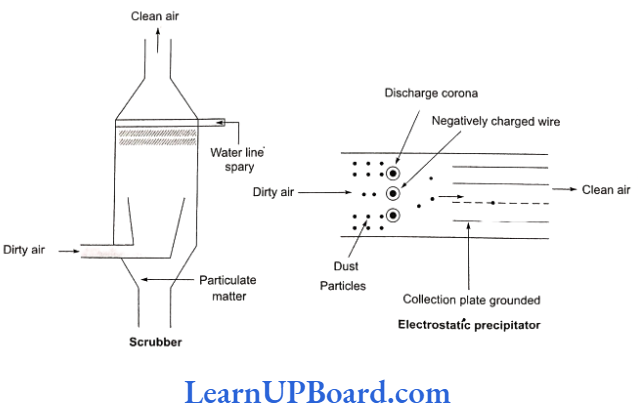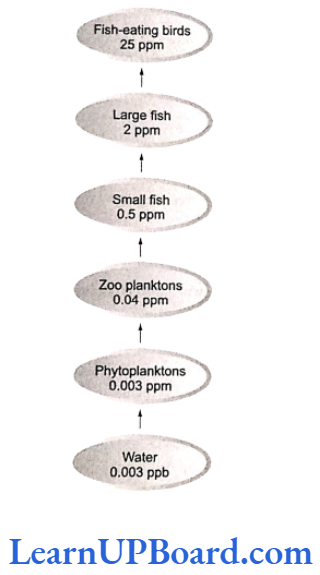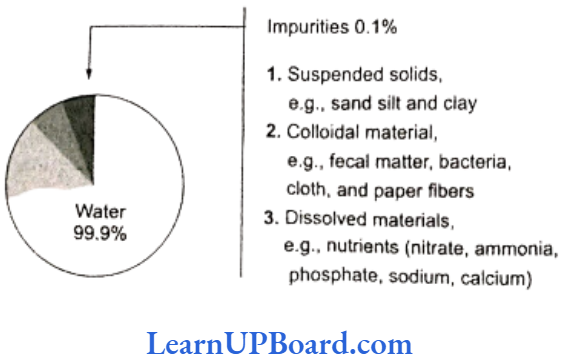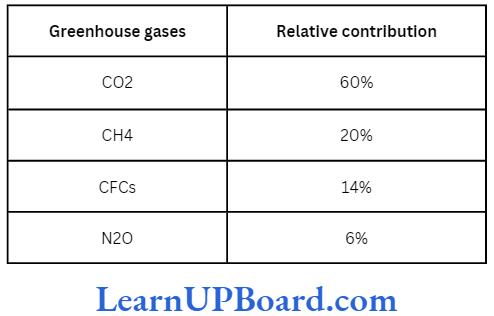NEET Biology For Environmental Issues Introduction
Human population size has grown enormously over the last hundred years with increase in demand for food, water, home, electricity, roads, automobiles, and numerous other commodities; and exerting tremendous pressure on our natural resources, along with contributing to the pollution of air, water, and soil. The need is to check the degradation and depletion of natural resources and pollution without halting the process of development.
Any undesirable change of the physical, chemical, or biological characteristics in the atmosphere, lithosphere, and hydrosphere which is harmful to man directly or indirectly is called pollution.
NEET Biology For Environmental Issues Kinds Of Pollution
- On the basis of part of environment where it occurs most
- Air pollution
- Water pollution
- Soil pollution
- On the basis of origin
- Natural: Examples are volcanic eruptions; release of CH4 by paddy fields and cattle; release of CO by plants and animals; emission of natural gas, O3, nitrogen oxides, cosmic rays, and UVrays; etc.
- Anthropogenic (man-made): Examples are burning of fossil fuels, deforestation, mining, sew- age, industrial effluent, pesticides, fertilizers, etc.
- On the basis of physical nature of pollutants
- Gaseous pollution
- Dust pollution
- Thermal pollution
- Noise pollution
- Radioactive pollution, etc.
Read and Learn More NEET Biology Notes
NEET Biology For Environmental Issues Pollutants
- Non-biodegradable: DDT, BHC, waste plastic bottles, polyethylene bags, used soft drink cans, etc.
- Biodegradable: Sewage, market garbage, livestock wastes, etc.
- Primary pollutant: CO and DDT.
- Secondary pollutant: Nitrogen oxides and hydrocarbons react photochemically to produce peroxyacyl nitrates and O3.
- Qualitative: Insecticides, weedicides, and fungicides.
- Quantitative: CO, CO2, NO, and NO2.
NEET Biology For Environmental Issues Air Pollution
Fifty-two percent of air pollution is caused by CO, 18% by SO2, 12% by hydrocarbons, 10% by particulates, 6% by nitrogen ox- ides, and 2% by the remaining matter.
Primary Air Pollutants
- Particulate matter
- Settleable: Diameter is 10 mm and settles out in less than a day.
- Suspended: Diameter is 1 mm and can remain suspended for weeks. Examples are aerosol, dust, mist, and fly ash.
Suspended particulate matter (SPM) (particularly of size 2.5 g or less) in troposphere causes and aggravates human respiratory illness such as asthma, chronic bronchitis irritation, and premature death. SPM in stratosphere alters the radiation and thermal budgets of the atmosphere, lowering the temperature at the earth’s surface.
- Carbon monooxide: It is a product of incomplete combustion of fossil fuels. 50% emissions are from automobiles. It produces COHb (carboxyhemoglobin) and reduces oxygen carrying capacity of blood, resulting in giddiness, decreased vision, headache, cardio- vascular malfunction, and asphyxia.
- Hydrocarbons (HCs) or volatile organic carbons (VOCs): These are produced naturally (c.g., CH4) or due to incomplete combustion. Benzene and HCHO are carcinogenic and cause irritation of eyes and mucous membrane and bronchial constriction. HCHO leads to indoor pollution.
- SO2: It is produced during the combustion of sulfur containing fossil fuels and smelting of ore from oil refineries. It causes eye irritation, severe respiratory problems, inhibits ETS in plants, and is also responsible for classical smog (London smog or sulfurous smog) and stone cancer.
- Nitrogen oxides (NO): These are mainly produced during the combustion of fossil fuels at high temperature in automobile engines. Nitrogen oxides cause brown air that leads to heart and lung problems.
Secondary Air Pollutants
Secondary air pollutants are formed through reaction between primary pollutants and often are more toxic.
- Photochemical smog (Los Angeles smog): It is a pollutant and is related to smog and fog.
- Acid rain: Sulfur dioxide and nitrogen oxide cause pollution by increasing acidity. Sulfuric acid is present in acid rain.
Air Pollution and Its Control
There are several ways of removing particulate matter; the most widely used of which is the electrostatic precipitator. It can remove over 99% particulate matter (PM) present in the exhaust from a thermal power plant. It has electrode wires that are maintained at several thousand volts, which produce a corona that releases electrons. These electrons attach to dust particles giving them a net negative charge.
The collecting plates are grounded and attract the charged dust particles. The velocity of air between the plates must be low enough to allow the dust to fall. A scrubber can remove gases such as sulfur dioxide. In a scrubber, the exhaust is passed through a spray of water or lime.
Recently, we have realized the dangers of particulate matter that are very-very small and are not removed by these precipitators. According to Central Pollution Control Board (CPCB), particulates of size 2.5 μm or less in diameter (PM 2.5) are responsible for causing the greatest harm to human health. These fine particulates can be inhaled deep into the lungs and can cause breathing and respiratory symptoms, irritation, inflammations and damage to the lungs, and premature deaths.

Catalytic converter has expensive metals such as platinum and palladium and can convert NO, to nitrogen and CO to CO2.
Controlling Vehicular Air Pollution: A Case Study of Delhi
Delhi leads the country in its levels of air-pollution-it has more cars than the states of Gujarat and West Bengal put together. In the 1990’s, Delhi ranked fourth among the 41 most polluted cities of the world. Air pollution problems in Delhi became so serious that a public interest litigation (PIL) was filed in the Supreme Court of India.
After being censured, the government was asked to take, within a specified time period, appropriate measures, including switching over the entire fleet of public transport, i.e., buses, from diesel to compressed natural gas (CNG). All the buses of Delhi were converted to run on CNG by the end of 2002. CNG has the following advantages:
- It burns most efficiently.
- It is cheaper than petrol or diesel.
- It cannot be siphoned off by thieves and adulterated like petrol or diesel.
- The main problem that government faced was the difficulty of laying down pipelines to deliver CNG through distribution points/pumps and ensuring uninterrupted supply.
- The use of unleaded petrol, low-sulfur petrol and diesel, and catalytic converters in vehicles; the application of stringent pollution-level norms for vehicles; etc., are the steps taken to reduce pollution.
- Stringent norms for fuels were given in the new auto fuel policy for steadily reducing the sulfur and aromatics content in petrol and diesel fuels. Euro II norms, for example, stipulate that sulfur be controlled at 350 parts-per-million (ppm) in diesel and 150 ppm in petrol. Aromatic hydrocarbons are to be contained at 42% of the concerned fuel. The goal, according to the roadmap prepared by the Indian Government, is to reduce sulfur to 50 ppm in petrol and diesel and bring down the level to 35%. Vehicle engines will also need to be upgraded.
- The Bharat Stage II (equivalent to Euro-II norms), which is currently in place in Delhi, Mumbai, Kolkata, Chennai, Bangalore, Hyderabad, Ahmadabad, Pune, Surat, Kanpur, and Agra, is applicable to all automobiles throughout the country since April 1, 2005.
- All automobiles and fuels petrol and diesel-were to have met the Euro-3 emission specifications in these 11 cities from April 1, 2005, and the Euro-4 norms by April 1, 2010. The rest of the country has Euro-3 emission norm compliant automobiles and fuels since 2010.
- A substantial fall in CO2 and SO2 levels has been found in Delhi between 1997 and 2005.
” environmental issues class 12 notes”
NEET Biology For Environmental Issues Water Pollution
Water pollution is the adverse change in the composition or condition of water such that it becomes less suitable for the purposes for which it would be suitable in its natural state.
Sources
- Point sources (e.g., sewage outlet of a municipal area or effluent outlet of a factory)
- Non-point sources (e.g., city storm water flow and agriculture runoff)
Pollutants
Various types of pollutants are as follows:
- Biological
- Chemical
- Physical
- Household detergents
- Domestic sewage
- Industrial wastes
- Offshore oil drilling
- Thermal power plants
- Pollution of detergents in water: It prevents the decomposition of organic compounds as it forms a thin film around them due to its low surface tension (surfactant nature). This results in the ac- cumulation of organic substances in water. There- fore, detergents are also called builders.
Effects
- Decreasing of dissolved O2 (DO or dissolved oxygen) content of water bodies.
- Higher biological oxygen demand (BOD): BOD is the amount of O2 in milligrams required to decompose organic matter present in 1 L water kept at temperature of 20°C for 5 days. If it is 4090 mg/L, then water is heavily polluted.
- COD (chemical oxygen demand): It indicates total O2 requirement of all O, consuming pollutant materials present in water. Its value is higher than BOD.
- Annelid worm Tubifex and some insect larvae act as indicator species for polluted waters.
- Persistent pesticides (e.g., DDT) and mercury pass into the food chain. Their increase in amount per unit weight of organism with the rise in trophic level is called biological magnification.
- Biomagnification of DDT causes hemorrhage, softening of brain, liver cirrhosis, hypotension, etc.

- Eutrophication is increase in the amount of nutrients in water due to detergents, pesticides, etc. It leads to organic loading, depletion of O2, etc.
- Minamata disease is caused due to mercury in water.

A Case Study of Integrated Waste Water Treatment
- Waste water including sewage can be treated in an integrated manner. An example of such an initiative is the town of Arcata (California).
- The town’s people created an integrated waste water treatment process within a natural system in collaboration with Humboldt State University.
- The cleaning occurs in two stages:
- The conventional sedimentation, filtering, and chlorine treatments are given. But after this stage, dissolved heavy metals still remain.
- Biologists developed a series of six connected marshes over 60 ha of marshland. Appropriate organisms were seeded into this area, which neutralize, absorb, and assimilate the pollutants. Hence, as the water flows through the marshes, it gets purified naturally; marshes also constitute a sanctuary.
- Friends of the Arcata Marsh (FOAM) are responsible for the upkeep and safeguarding of this wonderful project.
- Ecological sanitation is a sustainable system for handling human excreta using dry composting toilets. This is a practical, hygienic, efficient, and cost-effective solution by which human excreta can be recycled into a resource (as natural fertilizer), which reduces the need for chemical fertilizers. There are working “ecosan” toilets in many areas of Kerala and Sri Lanka.
Solid Waste
- Solid wastes refer to everything that goes out in trash.
- Sanitary landfills were adopted as the substitute for open-burning dumps wherein sanitary landfill wastes are dumped in a depression or trench after compaction and covered with dirt every day.
- But these sites are getting filled too and the seepage of chemicals, etc., from these landfills pollutes underground water resources.
- Anthropogenic waste is categorized into three types: (a) bio-degradable, (b) recyclable, and (e) non-biodegradable.
- Polyblend, a fine powder of recycled modified plastic, was developed by the company owned by Ahmed Khan in Bangalore. This mixture is mixed with bitumen, which is used to lay roads. Blends of polyblend and bitumen, when used to lay roads, enhanced bitumen’s water repellant properties and helped to increase road life by a factor of three.
- The use of incinerators is crucial for the disposal of hospital waste.
- Irreparable computers and other electronic goods are known as electronic wastes (e-wastes). e-wastes are buried in landfills or incinerated. Over half of the e-wastes generated in the developed world are exported.
- Developing countries such as China, India, and Pakistan import over half of the e-waste generated by developed countries for the recovery of metals such as copper, iron, silicon, nickel, and gold.
- Recycling is the only solution for the treatment of e-wastes, provided it is carried out in an environment-friendly manner.
NEET Biology For Environmental Issues Soil Pollution
- Soil pollution is the alteration in soil caused by the removal or addition of substances and factors which decrease its productivity and the quality of plants and ground water.
- Non-biodegradable materials such as polyethylene carry bags, waste plastic sheets, and bottles persist in soil for long periods.
- Hospital wastes also cause soil pollution.
- Excessive use of fertilizers causes soil deterioration and decreases the natural microflora.
- Mine dust destroys top soil and contaminates the area with toxic metals and chemicals.
- Recycling of solid wastes, burning of waste, utilizing heat to warm residential units, and generation of electricity is the best way to control soil pollution.
- Incineration (burning in the presence of O2 at 1200°C) and pyrolysis (combustion in the absence of O2 at 1650°C) methods can be used to eliminate solid wastes.
- Soil erosion and overgrazing are negative pollution.
Case Study of Organic Farming
Integrated organic farming is a cyclical, zero-waste procedure, where waste products from one process are cycled as nutrients for other processes. This allows the maximum utilization of resources and increases the efficiency of production. Ramesh Chandra Dagar, a farmer in Sonipat, Haryana, is doing just this. He includes bee-keeping, dairy management, water harvesting, composting, and agriculture in a chain of processes, which support each other and allow an extremely economical and sustainable venture.
There is no need to use chemical fertilizers for crops, as cattle excreta (dung) are used as manure. Crop waste is used to create compost, which can be used as a natural fertilizer or can be used to generate natural gas for satisfying the energy needs of the farm. Enthusiastic about spreading information and help on the practice of integrated organic farming, Dagar has created the Haryana Kisan Welfare Club, with a cur- rent membership of 5000 farmers.
Global Environment Change
CO2, CH4, N2O, and CFCs are radiatively active gases (also called greenhouse gases). The increased amounts of these gases in atmosphere are affecting the global climate. This phenomenon is known as global climatic change.
Greenhouse Gases and Global Warming
- The term “greenhouse effect” was coined by Arrhenius.
- Greenhouse gases trap the long-wave radiations. A part of this energy is re-radiated back to the surface of the earth. The downward flux of long-wave radiations by greenhouse gases is called greenhouse flux.
- The phenomenon of keeping the earth warm due to the presence of certain radiatively active gases in the atmosphere is called greenhouse effect, without which the average temperature of the earth would have been -18°C-20°C rather than the present average of 15°C.

- The excessive increase in the concentrations of these gases in the atmosphere would retain more and more infrared radiation, resulting in enhanced greenhouse effect.
- CFC is the most effective greenhouse gas (effectiveness is 14,000 times more than CO2).
Effects of Greenhouse Gases
- CO2 fertilization effect: An increase in the atmospheric concentration of CO2 increases the productivity of C3 plants and decreases the rate of transpiration due to partial stomatal closure.
- The possible effects of global warming are as follows:
- Increasing of global temperature (increased 0.6°C, most of it during the last three decades) and more extreme climatic conditions (El Nino effect).
- Warming of troposphere and cooling of stratosphere and thermosphere.
- Melting of ice caps.
- Rising of sea level; changes in rainfall pattern.
- Global warming will push tropics into temperate areas and temperate areas towards pole (shifting of climatic zones) and higher altitudes in mountains resulting in changed species distribution.
- Control measures: Reduced deforestation, cutting down use of fossil fuels, planting trees, and slowing down population growth.
- Ozone depletion
- Ozone layer is present in stratosphere at an altitude of 23-25 km (conc. 0.3 ppm). It acts as shield against UV radiation.
- A large hole has appeared in the ozone shield over Antarctica and a smaller one over North Pole (discovered by Farman in 1985).
- Ozone is commonly called chemical weed.
- CFC, CH4, CCl4, halogens, and N2O cause the destruction of O3. These are ozone depleting substances (ODS).
- CFCs are the most damaging. These release Cl atoms in the stratosphere which destroy O3.
- Thinning of the ozone layer results in an increase in the UV-B radiation.
- UV-B causes snow blindness.
- Nowadays, CFCs are being replaced by hydro- fluorocarbons (HFCS) and hydrochlorofluorocarbons (HCIFCs).
NEET Biology For Environmental Issues Radioactive Wastes
- The use of nuclear energy has two very serious inherent problems. The first is accidental leakage, as occurred in the Three Mile Island and Chernobyl incidents and the second is safe disposal of radioactive wastes.
- It causes mutations to occur at a very high rate. At high doses, nuclear radiation is lethal but at lower doses, it creates various disorders, the most frequent of all being cancer.
- It has been recommended that the storage of nuclear waste, after sufficient pre-treatment, should be done in suitably shielded containers buried within the rocks, about 500 m deep below the earth’s surface.
NEET Biology For Environmental Issues Degradation By Improper Resource Utilities And Maintenance
Soil Erosion and Desertification
- The fertile top-soil formation takes centuries. But it can be removed very easily due to human activities such as over-cultivation, unrestricted grazing, deforestation, and poor irrigation practices, resulting in arid patches of land. These barren patches extend and meet over time and create a desert.
- Desertification is becoming a major problem, particularly due to increased urbanization.
Water-logging and Soil Salinity
Water Logging
Water logging means a kind of physiological dry soil in which water is present but not available from plants.
Soil Salination
Soil salination is increase in the concentration of salts in a soil. It may develop due to the following reasons:
- The formation of soil from rocks having salts.
- Poor drainage and elevated water table.
- Nearness to sea.
- Continuous addition of fertilizers, etc.
Water logging and soil salinity are some of the problems that have come in the wake of the Green Revolution.
” environment issues class 12 notes”
NEET Biology For Environmental Issues Noise Pollution
Noise pollution is that form of sound energy which is not appreciated by human ears, i.e., it is undesired high level of sound.
- The frequency of sound is measured in hertz (Hz) while the unit of sound is decibel (dB).
- Moderate conversation = 60 dB
Loud conversation = 70 dB
Scooter = 30 de
Truck/bus = 90 dB
Jet aeroplane 150 dB
Rocket = 180 dB - Zone-wise permissible ambient noise levels are given in Table 16.2 (according to the Central Pollution Control Board).
- Green Muller scheme: It is growing of trees and shrubs in rows around the noisy area and road-sides to reduce intensity.

Effects of Noise Pollution
- A regular exposure to sound of 80 dB reduces hearing by 15 dB in 10 years.
- A sudden high intensity noise can damage ear drums.
- Noise pollution leads to anxiety, stress, insomnia, emotional disturbance, and hypertension.
NEET Biology For Environmental Issues Deforestation
- Deforestation is the conversion of forested areas to non-forested ones. It is estimated that almost 40% forests have been lost in the tropics, compared to only 1% in the temperate region.
- At the beginning of the 20th century, forests covered about 30% of the land of India. By the end of the century, it shrunk to 19.4%, whereas the National Forest Policy (1988) of India has recommended 33% forest cover for the plains and 67% for the hills.
- Trees are axed for timber, firewood, cattle ranching, and several other purposes. Slash-and-burn agriculture, commonly called as Jhum cultivation in the north-eastern states of India, has also contributed to deforestation.
- One of the major effects is enhanced carbon dioxide concentration in the atmosphere. It also causes loss of biodiversity due to habitat destruction, disturbs hydrologic cycle, causes soil erosion, and may lead to desertification in extreme cases.
- Reforestation is the process of restoring a forest. It may also occur naturally in a deforested area.
Case Study of People’s Participation in Conservation of Forests
- A Bishnoi woman of Khejarli village, Jodhpur, Rajasthan, named Amrita Devi showed exemplary courage by hugging a tree.
- The Amrita Devi Bishnoi Wildlife Protection Award is given to individuals or communities from rural areas that have shown extraordinary courage and dedication in protecting wildlife.
- Chipko Movement: It is the movement which was initially meant for protecting trees and not for the preservation of environment including habitat and wildlife. The Chipko Movement was born in March, 1973, in Gopeshwar in Chamoli district. The movement has two leaders: Chandi Prasad Bhatt of Gopeshwar and Sunder Lal Bahugana of Silyara in Tehri region. A similar movement was undertaken by Pandurang Hedge in the South. It is known as the Appiko Movement.
- The Government of India in 1980’s introduced the concept of joint forest management (JFM).
NEET Biology For Environmental Issues Assertion-Reasoning Questions
In the following questions, a statement of Assertion (A) is followed by a statement of Reason (R).
- If both Assertion and Reason are true and the reason is the correct explanation of the assertion, then mark (1).
- If both Assertion and Reason are true but the reason is not the correct explanation of the assertion, then mark (2).
- If Assertion is true but Reason is false, then mark (3).
- If both Assertion and Reason are false, then mark (4).
Question 1. Assertion: Euro 2 norms are framed to reduce the content of CO and aromatic compounds from fuels.
Reason: These compounds lead to reduced visibility and carboxyhemoglobin formation.
Answer. 4. If both Assertion and Reason are false, then mark (4).
Question 2. Assertion: Sewage discharge in a water body causes eutrophication.
Reason: This increases the organic content in water body and, hence, the growth of algal blooms.
Answer. 2. If both Assertion and Reason are true but the reason is not the correct explanation of the assertion, then mark (2).
Question 3. Assertion: Biomagnification of DDT can enhance the de- cline in bird population.
Reason: DDT causes thinning of egg shell and their premature breaking by disturbing calcium metabolism.
Answer. 1. If both Assertion and Reason are true and the reason is the correct explanation of the assertion, then mark (1).
Question 4. Assertion: Ecological sanitation is a sustainable system for handling human excreta.
Reason: It is a practical and hygienic method of using dry composting toilets.
Answer. 1. If both Assertion and Reason are true and the reason is the correct explanation of the assertion, then mark (1).
Question 5. Assertion: El Nino is a climatic change which causes deleterious environmental changes.
Reason: Increased tropospheric ozone due to El Nino causes shift of climatic regions.
Answer. 3. If Assertion is true but Reason is false, then mark (3).
